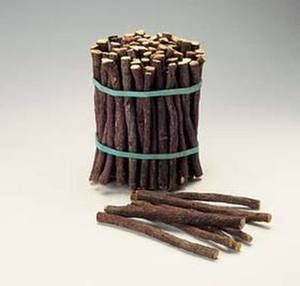Licorice is widely used not only as candy, but as a herbal remedy. The Chinese include licorice in herbal medicines used for digestion or subduing inflammations. Licorice root is also used as a dietary supplement for sore throats, ulcers and bronchitis. It has also been known to alleviate PMS symptoms. Glycyrrhizin, one of the active elements in licorice, possesses antidepressant effects and is being studied as a possible remedy for liver cancer.
The ancient Greek and Egyptians were known to have used licorice to cure everything from bad lungs to hepatitis. In fact, licorice sticks are purported to have been found in King Tutankhamen’s tomb.
Investigating a rumor supporting the fact that licorice is an aphrodisiac, I found that the root is frequently listed amongst other popular aphrodisiacs such as chocolate or oysters. The root was apparently once popular as a gift for female suitors in Germany.
There are, of course, side effects: too much licorice could raise blood pressure and cause hypertension and water retention. Pregnant and nursing women are advised to keep away from the licorice root
.
People who seek the licorice root as a dietary supplement usually ingest it in the form of a capsule or a liquid extract. It is also available as a delicious tea. However, the actual root is available as a regular snack- i is sold as ‘Licorice Sticks’.
As a child in Italy I first spotted the root in the hands of my friend’s older brother, who jokingly told me it was a real tree branch. Tasting the ‘branch’ proved to be an enlightening experience: this tree branch had a particularly sweet taste.
15 years later I found the root in an Italian store in Manhattan, NY, and immediately set out to see if it was as I remembered.
Happily chewing on my licorice root while reading Gorky, I realized that this flavorful stick could help dieters. Chewing on a root for an hour or so could be a great substitute for regular, absentminded snacking.
Consuming an entire stick takes time. You suck on the root, softening it and slowly chewing it as it releases a deliciously sweet flavor. After thoroughly taking advantage of an inch or so, some like to cut off the chewed part in order to get to the next segment, or simply turn over the stick.
It may sound crass on paper, but licorice roots are fun to chew on and tasty in an original way.
A box containing 5 licorice roots, each nearly 6 inches long, weighs 36 grams net.
Average nutritional values for 100 grams are given as follows:
Energy Value: Kcal 126
Water: 30 grams
Protein: 0 grams
Carbohydrates: 20 grams
Fat: 0 grams
Mineral Salt: 5 grams
Raw Fiber: 45 grams
Licorice should not be consumed in large amounts, but a stick a day could not hurt much, and could possibly be unobtrusive enough to be used at work



